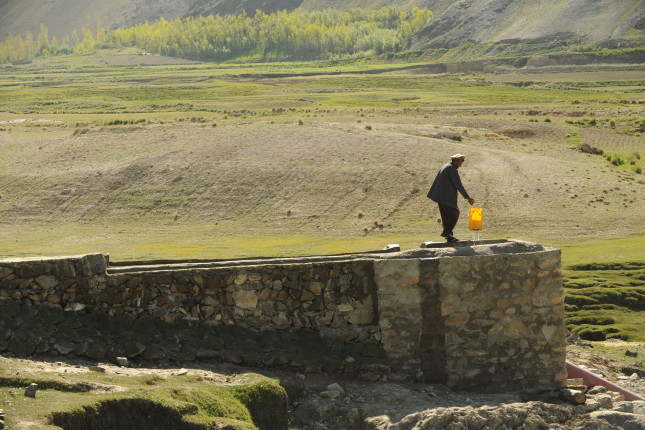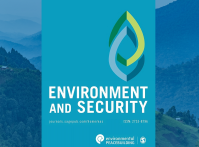-
Conflict, Crisis, and Peacebuilding: Afghanistan and Regional Water Security
June 12, 2023 By Elizabeth B. Hessami
Gunfire erupted at the border of the Afghan Nimroz Province and Iran’s Sistan-Baluchistan Province on May 27, 2023, amid rising tensions over water rights, killing troops on both sides.
Iranian and Afghan government officials have blamed each other for triggering the incident. But whatever the cause, the tensions over water flows between these nations have been simmering for at least a century. Indeed, in 1999, under the first iteration of the Taliban, flows were restricted completely causing damage to the delicate Hamoun Region—a registered UNESCO biosphere site of social and ecological importance.
Similar disputes have arisen at this moment. Earlier in May, Iranian President Ebrahim Raisi, accused Afghanistan of withholding their share of water, and stated publicly: “We will not allow the rights of our people to be violated.” The Taliban has denied these claims.
The truth is that neither side can afford a major armed conflict over water. According to recent WHO reports, 20 million Afghans are facing severe malnutrition, including 6 million who are at risk of famine. Food and energy security are of paramount importance.
Might hydro diplomacy provide an answer? The signs point to this possibility. Both the Islamic Emirate of Afghanistan (IEA) and Iranian officials have stressed the need for diplomatic solutions. And senior Iranian military officials were quick to de-escalate the current situation.
A Rapidly Drying Region of Critical Importance
The situation between Afghanistan and Iran over water has been a source of ire for both sides for decades. And while the two nations do have a recent history of hydro diplomacy (including the 1973 Helmand Water Treaty), historically there has been a marked lack of trust over riparian flows.
A changing climate’s impact on an already-dry landscape will only further exacerbate tensions. Afghanistan and Iran are both arid and semi-arid nations who depend on the waters flowing down from the Hindu Kush Mountain range. The life-giving water in the region flows from the 621 mile-long Helmand River—an endorheic river that empties into a series of wetlands and lakes called the Hamoun Biosphere Reserve, or “The Hamouns.”
The Helmand River is a critical source of drinking water, irrigation for agriculture, and fishing used by hundreds of thousands of people in Southern Iran and Afghanistan, but it is increasingly under threat from climate-related precipitation declines and increasing silt.
The Hamouns are also critical for migrating waterbirds, whose populations have dropped due to drought and dams. This region is an important ecological site registered by UNESCO, and attracts “190 migrant birds such as flamingo, pelican, crane, spoonbill, several kinds of duck, goose, swan, and coot” amongst its many villages.” (The Iranian side of the Hamouns is protected as well under the Ramsar Convention on Wetlands of International Importance.)
The people who have lived in this region for thousands of years are also under threat. According to UNESCO, the Hamouns are home to roughly 400,000 people, mainly of the Sistani group. Several nomadic tribes still depend on the Hamouns for their fisheries and livelihoods when there are sufficient water levels. The area is also home to many historical sites dating back to the Bronze Age.
Afghanistan’s Woes and Central Asia’s Climate Tensions
Afghanistan cannot afford a major armed conflict over water now—and it must proceed with caution. As of June 2023, no government has formally recognized the Taliban government, but its officials have taken control of 14 diplomatic missions. The Taliban government remains under stress due to a number of factors: internal ISIS insurgent attacks, global criticism over its human rights and women’s issues, economic sanctions, and increases in the cost of living. Drought and disease are also significant threats. A severe drought has impacted the nation’s agriculture, on which 80 percent of Afghans depend, and a fourth case of polio was detected recently in Nangahar Province.
Forty-three years of conflict with outside nations and internal insurgency forces have caused Afghans to flee their homelands at rate higher than other nations in every year since 1980. According to Amnesty International, “Afghan refugees represent one of the world’s largest protracted refugee population.”
Afghanistan’s place in the regional and global climate crises cannot be ignored, however. Despite its many woes, Afghanistan has contributed relatively little to the global problem of climate change, compared to highly industrialized nations. Yet it is also experiencing the devastating impacts much sooner than most nations as higher temperatures, floods, avalanches, and devastating droughts wreak havoc on the country.
The German Watch 2021 Global Climate Risk Index ranked Afghanistan as the sixth most affected country globally to climate-related threats. These events are destroying crops and contributing to further food insecurity ,and that can be destabilizing for a nation that has suffered from severe food insecurity over the past several years.
The Limits of a Treaty
Afghanistan has been torn apart by decades of conflict, and the Afghan people have suffered almost continuous conflicts and insurgencies, war after war, since 1979. Yet since Afghanistan threw off the yoke of British rule in the late 19th Century (and fought several other occupying forces since then), they also have sought full control over their waters.
These challenges have meant that the nation was never able to fully develop its hydropower capacity. But hydropower appears to be a major focus of Afghanistan’s government. The IEA’s Ministry of Energy and Water recently launched a new dam project (the Tori Dam in Zabul) and is now seeking to reboot significant hydropower projects begun under previous administrations that would increase food and energy security.
All of these efforts should be governed by 1973’s Helmand Water Treaty between Afghanistan and Iran. Under the Treaty, Iran is entitled to 26 cubic meters of water per second, or 850 million cubic meters per annum. According to the Treaty, the rest of the flows should be wholly under Afghan control.
David Laylin is the son of the late diplomat and lawyer John G. Laylin, who negotiated the Helmand Treaty. In an interview, he observes that his father was in a position to play this role because he had a long-standing relationship with Iran dating back to 1946, when he was asked to assist that nation with its complaint to the UN relating to Russia and Azerbaijan. He adds that the agreement negotiated by his father should be a boon for both countries: “Iran and Afghanistan, unlike most countries, are fortunate in that they have an agreement (that of the Helmand River Water Treaty of 1973) which they can use as a basis for negotiating the peaceful sharing of the [Helmand] River’s water.”
For instance, no such agreements were developed regarding the Nile, Tigris, Euphrates, and Mekong rivers—as well as other key transboundary waters. However, a number of global events (the Iranian Revolution and the Soviet invasion of Afghanistan in 1979) prevented the Helmand Treaty from being ratified or fully implemented. This state of affairs has caused further disputes.
But having an agreement, however imperfect, could help prevent more friction. The Helmand is considered a transboundary watercourse, and is therefore subject to international water laws (the 1997 UN Watercourses Convention and the 1992 United Nations Economic Commission for Europe (UNECE) Water Convention) that stipulate that Afghanistan and Iran must share the waters “under the applicable treaty and customary law.”
Trouble (and Hope) in the Neighborhood
The fear of a major war erupting over water is a source of global anxiety, whether it is in the Middle East, or in the South or Central Asian States. But while there have been many skirmishes, such as the one last week between Afghanistan and Iran, there has never yet been a major war declared over water.
The bad news for Afghanistan is that the dust-up with Iran is not the only riparian issue it has with its neighbors. The Emirate has developed a new canal in Balkh Province called the “Qosh Tepa” canal that will divert up to 10 billion cubic meters from the Amu Darya each year.
The IEA has devoted significant resources to the canal, and at the end of 2022, it was about a quarter of the way finished. This canal will irrigate hundreds of hectares of land, and Afghan officials believe it will greatly increase food security. Yet Afghanistan’s downstream riparian neighbors, Uzbekistan and Turkmenistan, are very nervous about the project—especially since the Amu Darya basin already has a history of overuse.
Yet diplomacy may yet win the day. Iran’s IRNA news agency reported that Ali Selajqa, Vice President and Head of Iran’s Environmental Protection Organization, had announced upcoming meetings with representatives of the IEA. Such peacebuilding efforts are essential, and there is solid precedent for avoiding conflict through continued communication and meetings.
After all, the successful 1960 Indus Water Treaty has weathered many conflicts and maintained the fragile peace between India and its neighbors. Communication through continued meetings and improving the installed technology for monitoring water flows and climate impacts in the area are critical to maintaining and building a durable peace between the two nations.
Elizabeth B. Hessami, J.D., LL.M. (Environmental Law), is a licensed attorney and Faculty Lecturer of International Environmental Policy and Environmental and Natural Resources Security for The Johns Hopkins University. She has served as a Visiting Attorney for the Environmental Law Institute (remote) for nearly a decade.
Sources: Al-Arabiya; Al Jazeera; Amnesty International; AP; CNN; The Diplomat; EJIL: Talk!; German Watch; International Water Law; Iranica; Khaama Press Agency; The Print; Radio Free Europe/Radio Liberty; Ramsar Sites Information Service; Relief Web; Salam Watandar; Stimson; Tehran Times; Tolo News; UN; UNESCO; UNHCR; USIP
Photo credit: Man walks 4 miles to draw clean water from a pump above a mountain stream in Warduj, Afghanistan, courtesy of Maximum Exposure PR/Shutterstock.com.
 A Publication of the Stimson Center.
A Publication of the Stimson Center.






